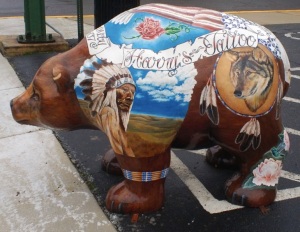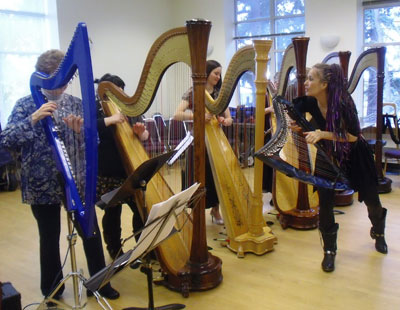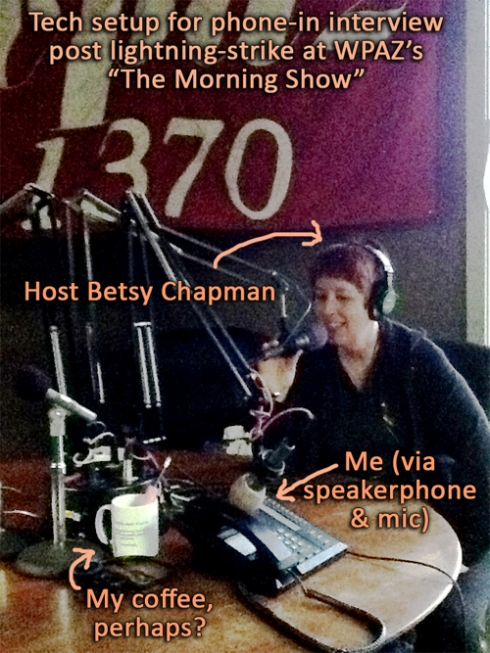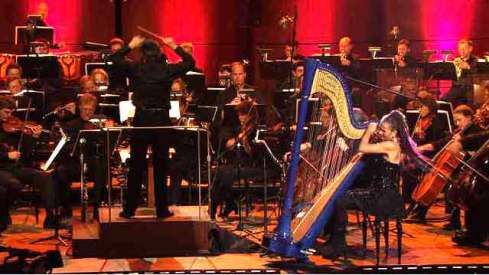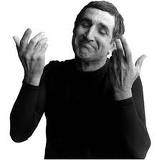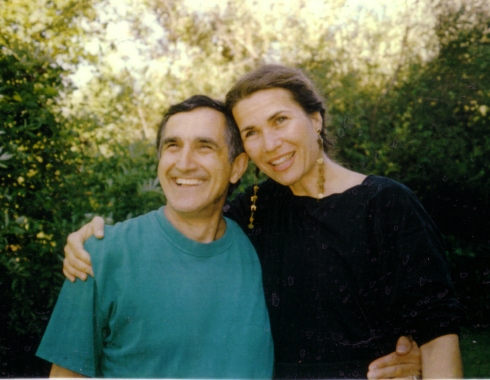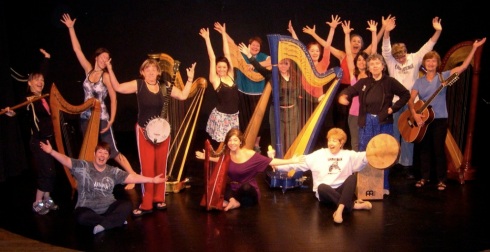You are currently browsing the tag archive for the ‘workshop’ tag.
… after a ridiculously early Sunday morning flight, jazz harpist Susan Ottzen picked me up at the Atlanta airport and brought me to the Atlanta Harp Center, where I immediately took a nap on the floor of the Harp Storage Room (it was like bedding down in a forest of towering harps – really).
Then I spent a rollicking afternoon with 13 intrepid harp players, singing and playing the Blues.
This was a workshop that mixed four things: passion, Blues, adult beginners and professional musicians. And here’s what I love about that:
As adult beginners, the adult part of us has a choice:
We can use our adult mind to strategize a path for the beginner … or we can revert to being a tantrum-throwing juvenile. Both are fun. But if you go for the first, as a musician, you can use your strategic adult mind to simplify music so that you can enjoy playing with others even if they’re “way beyond you.”
Unlike running with people beyond your ability. Trust me, I know.
If you’re a slow runner, like me, you can’t really run “with” a fast runner and both of you be challenged, engaged and comfortable. Even if you start off at the same time, they’ll be ahead of you within a few steps (did I mention my husband is a marathon trainer?).
But music moves at the same rate no matter who’s playing.
So if you’re a beginner who knows the secrets of simplifying, then you can decide to play fewer notes and still play music together with people of far greater technical ability. Sure, they may be playing 10 times more notes than you (or 20 or 30 times) — but you’re still playing the music together. The strategy comes in knowing which ones to leave out.
And, by the way, I learned this many times in my life, once from the great bass-player, Rufus Reid.
So I was really excited to have players with a huge range of skills – from Susan Ottzen, who teaches jazz harp – to a student who’d only just had her first 3 harp lessons. So how did this all happen?
I’m working on two education-type projects right now:
One’s called “Blues by the Dozen” and the other is called “Strings of Passion:”
The Blues project is about creating simple, immediately playable structures and the Passion project is about revealing underlying principles.
So one is about learning through doing, and the other is about deconstructing an idea — the idea of passion in performance — so we can find it, practice it and explore it everywhere in our lives.
In “Strings of Passion,” the point is to create an “Enhancement Loop” (I just made that up, so don’t bother Googling it), where exploring the expression of passion in life gives us insight and connection to performing with passion as performing artists – and exploring passion in performing arts enhances how we live with passion.
In the Blues project, the point is to just get your fingers on the notes, sing, play and have a rollicking good time. You learn a ‘technique’ and immediately put it into practice.
‘Til now I’ve always thought of “technique” workshops and “concept” workshops as – well, basically as opposites — even though I use a lot of physicalizing in concept workshops.
I wanted to see what would happen if I put these two ideas together in a workshop: I wanted to combine a simple playable structure with concepts of passion and performance — within a fairly short amount of time.
And, judging by the experience of 12 harpists belting out the Blues on harp and voice, the experiment was a success!
What I discovered was that by describing principles of impassioned performance before we even started learning notes, and by telling just a few stories to put the principles into context, the level of performance in people’s playing was so much freer right off the bat, in terms of physical investment and energy. (And remember, this was a mixed group of professionals and adult-beginners – each of whom have different issues when it comes to freely expressing themselves through music).
So I’m excited to continue exploring this in future workshops and I’ll keep you posted!
It turns out I’ll be doing a lot of this in March at the “Beginning in the Middle” retreat near Richmond, VA. This is an entire learning retreat just for adult beginners on harp.
I’ve heard about this festival for years, loved the idea and always wanted to give my workshops at it — and 2012 is the first time it’s worked out with my schedule. So if you know an adult-beginner harpist or a harpist wannabe, tell them about “Beginning in the Middle” – or, heck! Buy them a registration for Christmas!
Me, I’m off to begin in the middle of dinner …
NOTES FROM TOUR:
When I asked our host of last Tuesday’s Workshop, Betsy Chapman, what to expect in Boyertown, PA – and a little bit about Marianne, the owner of the beautiful Inn we’d be staying in, Betsy sent me this email. While I was there, I took these photos.
Marianne Deery is the Mayor of Boyertown, the town I live in.
Here in Boyertown we have Bear Fever – our mascot, the Boyertown Bear can be found all around town in various guises – a Doctor Bear in front of the medical center, a laywer Bear in front of Borough Hall, a dentist bear – you get the idea. These Bears were all created by a coalition of businesses, students, and townspeople to bring collaborative public art to our town.
Boyertown is “A Special Kind of Place” – a town of 4,000 residents that boasts its own Farmer’s Market, has a Museum of Historic Vehicles that is recognized for it’s excellent collection by the Smithsonian, a fabulous 1912 restored theater for movies and live performances, Studio B, a non-profit art gallery, and a main street of locally owned businesses that make it hard to want to shop anywhere else!
We have an important place in the history of theater as well – in 1908 a fire in the Rhoades Opera House killed 171 people, and wiped out whole families. That fire caused many of the fire-safety laws to be written that are still in effect.
Note that all doors in theater open out, remain unlocked during performances, and have panic bars. Many exits are required, not just one door. Curtains must be fire-resistent. Exit signs are clearly marked and lighted. Fire extinguishers are in prominent places, etc.,etc., etc. All thanks to a fire in our little town.
As for Mayor Marianne? Besides being renowned for her baking, it is an open secret that her favorite duties as mayor are tapping the first keg of beer at our annual Oktoberfest, and performing wedding ceremonies. Not necessarily in that order!
So … you like bears? Get thee to Boyertown!
“Baroque Flamenco” is one of my most fiery & dramatic pieces that’s the dramatic finale of PBS music special “Invention & Alchemy” and the 3rd movement of my concerto “Soñando en Español.” (Read about the piece in this blog). Now the piece is in the hands of many other harpists …
(Sign up for the next hands-on workshop)
In 2008 I arranged “Baroque Flamenco” for other harpists to play, and instead of just making a single arrangement, I created 3 arrangments: one for beginners, one for intermediate players, and the concert version I play, myself, for advanced players. All the versions are playable on concert harp, and the beginning & intermediate versions are also playable on the lever harp (also called “Folk Harp” or “Celtic Harp.” You can see both concerts harps and lever harps – the blue one, and the one I’m playing – in the photo below)
So now harpists all over the world are playing this piece. But to really play the piece – to bring it alive — you need to not just play the notes, but also play the “character” of the piece — and that’s the kind of thing you can’t pass on via written notes.
So I created a hands-on workshop specifically for learning how to express the character of the piece — which is both the simplest, and the hardest part of the music.
To work on that, we use a simplified version of the piece, so that players on all levels, from beginning to advance, can work together at the same time. Interestingly, it’s often the less advanced players who have an easier time connecting with the ‘character’ of the piece, so working together in a multi-level environment is useful to everyone.
For that same reason, I invite any advanced players to present a brief section of the piece during short “Master Class” interludes, so that the entire class can learn from watching these short one-on-one sessions (which are also a nice break from the playing … well, for everyone except the ones presenting!).
By the end of the evening, everyone knows how to ‘get this piece across’ to an audience, regardless of their skill level, and they can then take that understanding and apply it to whatever level of the piece they’re working on. They also get my tips on practice techniques for Baroque Flamenco and ideas for developing their own unique performances of the piece.
I love sharing this in person because as a composer I have a limited language through just written notes – but when I can be in the same room with you, and show you exactly what I mean, musically, you’re getting all the music, not just the notes. You get to literally look over my shoulder. You get to experience the passion of the piece – you get the living music and then you become part of the life of that piece.
THE NEXT HANDS-ON “BAROQUE FLAMENCO” WORKSHOP: is Fri. Sept. 30 at Kolacny Music in Denver, CO. Get more info or sign up here.
I had a radio interview yesterday morning on WPAZ, Pennsylvania’s tiniest radio station (“with the biggest heart!”). The station had been struck by lightning the night before so they had to create an alternate tech set-up for my phone interview (see below). You can listen to that interview here:
I love the mic placement at the speakerphone, and especially love that even though I wasn’t there … they still provided morning coffee.
Hey, it ain’t called “The Morning Show” for nothin’!
Radio host Betsy Chapman will also be hosting my “Fireworks for the Creative Spirit” workshop on Tue. Sept. 27 at the Tri-Country Performing Arts Center. There are a couple of spots left as of this writing. Here’s where you can get more info about the workshop is and how to register.
RELATED POST: Betsy sent me questions ahead-of-time (most of which she didn’t ask in the interview) but I experimented with writing out the answers in advance. You can see the first question “Why the Harp?” here.
I got a set of questions from Betsy Chapman, who hosts “The Morning Show” on WPAZ, a tiny station (“with a big heart!”) in Pennsylvania. WPAZ is co-sponsoring my “Fireworks for the Creative Spirit” next week, so Betsy interviewed me on air. But first she sent her questions, starting with the question I most dread and am most often asked. So I started writing to find out what my answer would be this time:
Q: So … why the HARP?
A: This is a question I ask myself over and over. Did I play the harp as avoidance for writing musical theater, which is my first love? Because it was an incredible physical challenge, a way I could be both an athlete and a musician at the same time? Is it because it was an underdog instrument? Is it because it was so identified with women, and so marginalized in the music world, that I felt like I wanted to liberate it in some way?
If someone had told me it is THE traditional storytelling instrument through history, that might have made me choose it. But I did NOT know that.
If someone had told me it’s the missing link between the piano and the guitar, with all the double-handed dexterity of the piano but the ability to get right in on the strings and bend them and snap them like a guitar – that might have done it. But I didn’t know that either.
So I honestly don’t know why I STARTED. But I kept going for many reasons. First, the challenge. Practicing the harp completely enveloped my mind. The dexterity between hands and feet, it calmed my mind and focused me in a way that nothing else did. I think that my brain and my body needed something to connect them in that way: something complex and intricate, that required huge physical coordination and physical strength. I found that very satisfying.
I also loved the excuse to get dressed up in long gowns, high-heels, rhinestones and red-red lipstick, and I loved that I could pay my way through school by playing in dining rooms — PLUS I got free food.
When I started focusing on jazz, then again was the physical challenge I loved, and the understanding that by practicing a structure, I could eventually have huge musical freedom.
Then, later on, I fell in love with the international community of harp builders and players. Which is good because a few years after that, I developed this idee fixe: the idea that it must be possible to strap on the harp, play it like an electric guitar. And that was something I couldn’t make happen on my own.
NEXT BLOG: “WHY ELECTRIC HARP?
Solo Concert – Wed. Mar. 30th, 2011 – 7:30 pm
“The Shedd Institute for the Arts” in Eugene, OR
Read the full release, including info on the special Hands-On Arranging Workshop for Musicians Tue. Mar. 29 from 7-10pm
She strides onto stage like a rock-star, with an electric blue triangle wired with 32 multi-color strings. She plays, she sings, she tells tall tales about her life. She’s the harpist your parents never warned you about: the electric harpist.
Henson-Conant is a one-woman orchestra, using a “looper-pedal” to layer sounds from her harp in real time, then weaving solo lines and vocals above it. Forget the demure harpist – Henson-Conant is a showman, entertainer and solid musician who’s been compared to artist-performers from Leonard Bernstein to Elvis Presley and Van Halen. She’s been featured on CBS Sunday Morning, The Today Show and NPRs Weekend Edition, and has starred in two full-length PBS music specials.
 Her signature instrument was invented and named for her (the “DHC Blue-Light”). It weighs 11 lbs, has 32 strings and is made of carbon fibre. Created for her by the CAMAC Harp Company in France, it’s now one of the fastest-selling new harp models in the world.
Her signature instrument was invented and named for her (the “DHC Blue-Light”). It weighs 11 lbs, has 32 strings and is made of carbon fibre. Created for her by the CAMAC Harp Company in France, it’s now one of the fastest-selling new harp models in the world.
Henson-Conant’s voice is compared to Carly Simon and Joan Baez; her playing to Chuck Berry and Jimi Hendrix; and her humor to musical comedian Victor Borge. The shows are tied together by powerful, funny, affirming stories and universal humor. Her website, HipHarp.com and YouTube channel, YouTube.com/HipHarpist give a good overview of what you can expect at the show.
She’ll perform a solo show Wed. Mar. 30, 2011 at 7:30 and an open workshop called “Arrange It” on the art and skill of arranging – for all musicians, all levels on Tue. Mar. 29, 2011 from 7-10pm . Both events are at The Shedd – 868 High St. – Eugene, OR 97440.


